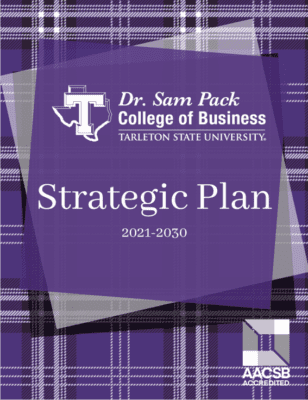
Overview
The Dr. Sam Pack College of Business (DSPCOB) is dedicated to preparing students for leadership roles in a rapidly evolving global economy. Our Strategic Plan (2021-2030) serves as a roadmap for growth, innovation, and continuous improvement, aligning with Tarleton State University’s Strategic Plan while addressing the unique needs of business education.
📄 View the DSPCOB Strategic Plan
📄 View the Tarleton State University Strategic Plan
Mission
The Dr. Sam Pack College of Business empowers all learners with the knowledge, skills, and ethical principles to thrive in the global economy. Through faculty and student interactions we prepare leaders who positively impact organizations, foster economic growth, and contribute to their communities.
Strategic Focus Areas
To fulfill our mission, the Strategic Plan focuses on five key areas that guide decision-making, program development, and resource allocation.
1. Student Access & Success
- Expand flexible learning formats, including online, hybrid, and evening courses to accommodate various student needs.
- Strengthen career development initiatives, ensuring internship and networking opportunities.
- Enhance support for working professionals and first-time college students.
2. Academic Excellence & Innovation
- Maintain high academic standards through curriculum updates and program development.
- Support faculty research and encourage applied learning experiences.
- Equip students with industry-relevant skills through modern coursework and experiential learning.
3. Leadership & Global Engagement
- Develop leadership programs, such as the DSPCOB Leadership Academy, to foster professional growth.
- Expand international learning opportunities through global business collaborations and virtual experiences.
- Strengthen partnerships with industry leaders to enhance student engagement and career pathways.
4. Faculty Excellence & Scholarship
- Recruit and retain high-quality faculty committed to research, teaching, and industry engagement.
- Increase faculty support for scholarly research, focusing on high-impact publications.
- Encourage faculty to engage in interdisciplinary collaborations that enhance student learning.
5. Organizational Excellence & Continuous Improvement
- Implement data-driven decision-making to optimize student success and resource allocation.
- Maintain a culture of assessment and accountability, ensuring continuous progress.
- Enhance stakeholder involvement, including input from students, faculty, and business leaders.
Commitment to Continuous Improvement
The DSPCOB Strategic Planning Committee actively monitors progress, adapts strategies, and ensures that the College’s efforts remain aligned with Tarleton State University’s broader goals. This approach fosters growth, innovation, and long-term success.
📄 View the full DSPCOB Strategic Plan (2021-2030)
📄 View the Tarleton State University Strategic Plan